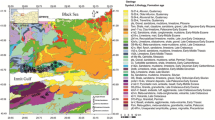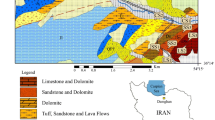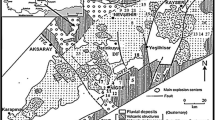Abstract
The quality of large rock blocks produced from quarries depends significantly on the fractures and the extent to which they penetrate into the rock. The paper reports a laboratory study to evaluate the possibility of the determining fracture depth in rock blocks from P-wave velocity. Three igneous, three sedimentary and three metamorphic rocks were studied. Inverse linear relations were found between the fracture depths and the P-wave velocities. Although, the slope of the regression lines is approximately the same for the rocks belonging to one rock class, different trends are seen for the different rock types. In addition, some correlation was found between the slopes of the regression lines and the physical properties of the rocks.
Résumé
La qualité des gros blocs extraits en carrière dépend de la présence de fractures et de leur extension au sein des masses rocheuses. L’article présente une étude de laboratoire visant à évaluer la profondeur de pénétration de fractures dans un bloc de roche à partir de la mesure des vitesses de propagation des ondes P. Trois roches magmatiques, trois roches sédimentaires et trois roches métamorphiques ont été étudiées. Des corrélations inverses entre la profondeur des fractures et la vitesse des ondes P ont été trouvées, avec des types de relation variables suivant les types de roche. De plus, des relations ont été établies entre les pentes des droites de régression et les propriétés physiques des roches.














Similar content being viewed by others
References
Boadu FK (1997) Fractured rock mass characterization parameters and seismic properties: analytical studies. J Appl Geophys 36:1–19
Boadu FK (2000) Predicting the transport properties of fractured rocks from seismic information: numerical experiments. J Appl Geophys 44:103–113
Christaras B (2003) P-wave velocity and quality of building materials. In: Proc Int Symp Industrial Minerals and Building Stones, pp 295–300
Christaras B, Mariolakos I, Foundoulis J, Athanasias S, Dimitriou A (1997) Geotechnical input for the protection of some Macedonian Tombs in Northern Greece. In: Proc 6th Int Symp Conservation of Monuments in the Mediterranean Basin, pp 125–132
D’Andrea DV, Fischer RL, Fogelson DE (1965) Prediction of compressive strength from other rock properties. US Bureau of Mines Report of Investigations 6702
Dearman WR, Turk N, Irfan Y, Rowshanei H (1987) Detection of rock material variation by sonic velocity zoning. Bull Int Assoc Eng Geol No 35:3–8
Deere DU, Miller RP (1966) Engineering classification and index properties for intact rock. Air Force Weapons Lab. Tech. Report, AFWL-TR 65–116, Kirtland Base, New Mexico
Gardner GHF, Gardner LW, Gregory AR (1974) Formation velocity and density: the diagnostic basis for stratigraphy. Geophys 39:770–780
Gaviglio P (1989) Longitudinal waves propagation in a limestone: the relationship between velocity and density. Rock Mech Rock Eng 22:299–306
Gladwin MT (1982) Ultrasonic stress monitoring in underground mining. Int J Rock Mech Min Sci 19:221–228
Hudson JA (1981) Wave speed and attenuation of elastic waves in material containing cracks. Geophys J R Astr Soc 64:133–150
Hudson JA, Jones ETW, New BM (1980) P-wave velocity measurements in a machine bored chalk tunnel. Q J Eng Geol 13:33–43
Inoue M, Ohomi M (1981) Relation between uniaxial compressive strength and elastic wave velocity of soft rock. In: Proc Int Sym Weak Rock, pp 9–13
ISRM (1981) Suggested methods. In: Brown ET (ed) Rock characterisation testing and monitoring. Pergamon Press, Oxford
Kahraman S (2001) A correlation between P-wave velocity, number of joints and Schmidt hammer rebound number. Int J Rock Mech Min Sci 38:729–733
Kahraman S (2002) The effects of fracture roughness on P-wave velocity. Eng Geol 63:347–350
Karpuz C, Pasamehmetoglu AG (1997) Field characterization of weathered Ankara andesites. Eng Geol 46:1–17
King MS, Chaudhry NA, Shakeel A (1995) Experimental ultrasonic velocities and permeability for sandstones with aligned cracks. Int J Rock Mech Min Sci 32:155–163
Knill TL (1970) The application of seismic methods in the interpretation of grout takes in rock. In: Proc Conf In situ investigation in soils and rocks. British Geotechnical Society No 8:93–100
O’Connel RJ, Budiansky B (1974) Seismic velocities in dry and saturated cracked rock. J Geophys Res 79(35):5412–5426
Onodera TF (1963) Dynamic investigation of foundation rocks, in situ. In: Proc 5th US Symp Rock Mech, pp 517–33
Price DG, Malone AW, Knill TL (1970) The application of seismic methods in the design of rock bolt system. In: Proc First Int Congr. Int Assoc Eng Geol 2:740–752
Turk N, Dearman WR (1986) A suggested approach to rock characterization in terms of seismic velocities. In: Proc 27th US Symp Rock Mech, pp 168–175
Turk N, Dearman WR (1987) Assessment of grouting efficiency in a rock mass in terms of seismic velocities. Bull Int Assoc Eng Geol 36:101–108
Watanabe T, Sassa K (1995) Velocity and amplitude of P-waves transmitted through fractured zones composed of multiple thin low-velocity layers. Int J Rock Mech Min Sci 32:313–324
Young RP, Hill TT, Bryan IR, Middleton R (1985) Seismic spectroscopy in fracture characterization. Q J Eng Geol 18:459–479
Zezza F (1993) Evaluation criteria of the effectiveness of treatments by non destructive analysis. In: Proc 2nd Course of CUN Univ School of Monument Conservation, pp 198–207
Acknowledgment
This work has been supported by the Turkish Academy of Sciences, in the framework of the Young Scientist Award Program (EA-TUBA-GEBIP/2001-1-1).
Author information
Authors and Affiliations
Corresponding author
Rights and permissions
About this article
Cite this article
Kahraman, S., Soylemez, M. & Fener, M. Determination of fracture depth of rock blocks from P-wave velocity. Bull Eng Geol Environ 67, 11–16 (2008). https://doi.org/10.1007/s10064-007-0110-5
Received:
Accepted:
Published:
Issue Date:
DOI: https://doi.org/10.1007/s10064-007-0110-5




